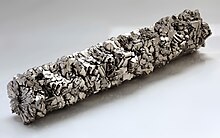Chemical element with atomic number 22 (Ti)
Titanium, 22 Ti Pronunciation Appearance silvery grey-white metallic
Atomic number (Z ) 22 Group group 4 Period period 4 Block d-block Electron configuration [Ar ] 3d2 4s2 Electrons per shell 2, 8, 10, 2 Phase at STP solid Melting point 1941 K (1668 °C, 3034 °F) Boiling point 3560 K (3287 °C, 5949 °F) Density (at 20° C) 4.502 g/cm3 [ 4] when liquid (at m.p. ) 4.11 g/cm3 Heat of fusion 14.15 kJ/mol Heat of vaporization 425 kJ/mol Molar heat capacity 25.060 J/(mol·K) Vapor pressure
P (Pa)
1
10
100
1 k
10 k
100 k
at T (K)
1982
2171
(2403)
2692
3064
3558
Oxidation states common: +4 ? [ 5] [ 6] ? [ 7] [ 5] [ 5] Electronegativity Pauling scale: 1.54 Ionization energies 1st: 658.8 kJ/mol 2nd: 1309.8 kJ/mol 3rd: 2652.5 kJ/mol (more ) Atomic radius empirical: 147 pm Covalent radius 160±8 pm Spectral lines of titaniumNatural occurrence primordial Crystal structure hexagonal close-packed (hcp) (hP2 ) Lattice constants a = 295.05 pmc = 468.33 pm (at 20 °C)[ 4] Thermal expansion × 10−6 [ a] Thermal conductivity 21.9 W/(m⋅K) Electrical resistivity 420 nΩ⋅m (at 20 °C) Magnetic ordering paramagnetic Molar magnetic susceptibility × 10−6 3 /mol (293 K)[ 8] Young's modulus 116 GPa Shear modulus 44 GPa Bulk modulus 110 GPa Speed of sound thin rod 5090 m/s (at r.t. ) Poisson ratio 0.32 Mohs hardness 6.0 Vickers hardness 830–3420 MPa Brinell hardness 716–2770 MPa CAS Number 7440-32-6 Discovery William Gregor (1791) First isolation Jöns Jakob Berzelius (1825) Named by Martin Heinrich Klaproth (1795)
Category: Titanium references
child table, as reused in {IB-Ti}
^ "titanium" . Lexico UK English DictionaryOxford University Press . Archived from the original on 2019-12-20.^ "Standard Atomic Weights: Titanium" . CIAAW . 1993.^ Prohaska, Thomas; Irrgeher, Johanna; Benefield, Jacqueline; Böhlke, John K.; Chesson, Lesley A.; Coplen, Tyler B.; Ding, Tiping; Dunn, Philip J. H.; Gröning, Manfred; Holden, Norman E.; Meijer, Harro A. J. (2022-05-04). "Standard atomic weights of the elements 2021 (IUPAC Technical Report)" . Pure and Applied Chemistry . doi :10.1515/pac-2019-0603 . ISSN 1365-3075 . ^ a b Arblaster, John W. (2018). Selected Values of the Crystallographic Properties of Elements . Materials Park, Ohio: ASM International. ISBN 978-1-62708-155-9 ^ a b c Greenwood, Norman N. ; Earnshaw, Alan (1997). Chemistry of the Elements (2nd ed.). Butterworth-Heinemann . p. 28. ISBN 978-0-08-037941-8 ^ Jilek, Robert E.; Tripepi, Giovanna; Urnezius, Eugenijus; Brennessel, William W.; Young, Victor G. Jr.; Ellis, John E. (2007). "Zerovalent titanium–sulfur complexes. Novel dithiocarbamato derivatives of Ti(CO)6 :[Ti(CO)4 (S2 CNR2 )]− ". Chem. Commun. (25): 2639–2641. doi :10.1039/B700808B . PMID 17579764 . ^ Andersson, N.; et al. (2003). "Emission spectra of TiH and TiD near 938 nm". J. Chem. Phys . 118 (8): 10543. Bibcode :2003JChPh.118.3543A . doi :10.1063/1.1539848 . ^ Weast, Robert (1984). CRC, Handbook of Chemistry and Physics . Boca Raton, Florida: Chemical Rubber Company Publishing. pp. E110. ISBN 0-8493-0464-4 ^ a b Kondev, F. G.; Wang, M.; Huang, W. J.; Naimi, S.; Audi, G. (2021). "The NUBASE2020 evaluation of nuclear properties" (PDF) . Chinese Physics C . 45 (3): 030001. doi :10.1088/1674-1137/abddae . Cite error: There are <ref group=lower-alpha> tags or {{efn}} templates on this page, but the references will not show without a {{reflist|group=lower-alpha}} template or {{notelist}} template (see the help page ).

